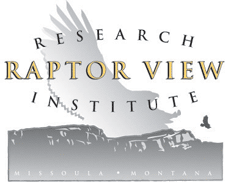
Threats to Survival
In the wild, without human encroachment, the osprey has very few predators. Ospreys are the top predator in the aquatic ecosystems where they live and hunt. Therefore, very rarely are adult osprey at risk of predation. Equipped with large strong talons and sharp beaks for tearing the flesh of their aquatic prey, osprey
Osprey
As top predators of their ecosystems, raptors are highly susceptible to negative impacts from environmental contaminants such a mercury, cadmium, lead, aluminum, and arsenic. The most common, and most deadly, contaminant affecting osprey is mercury. In areas of high mercury contamination, osprey egg mortality can be as high as fifty percent. In her book The Call of the Osprey written about the Montana Osprey Project, Dorothy Hinshaw Patent explains the concept of bioaccumulation in ecosystems “Toxins get amplified by about ten times the original concentration in the environment with each step of the food chain” (Patent, 24). Since osprey
Heavy Metal Studies
Heavy metal contamination is a big challenge facing Clark Fork River ospreys. Establishing baseline data on heavy metal concentrations in osprey blood is one of the hallmarks of this study. By determining contamination levels, researchers can assess the overall health of the river ecosystem and start to examine the long-term effects of these heavy metals.

Iris brings in a fish for the Hellgate chicks. Photo courtesy of William Munoz.
Ospreys (Pandion haliaetus) are a valuable indicator species because they are at the top of the food chain and have one main food source—fish. Ospreys hunt close to the nest, which means the chicks have only eaten food from a very specific area. And true to the maxim “you are what you eat,” heavy metals from the river, some of which are concentrated in fish, then get into the osprey chicks’ blood. These measurements are a barometer of the whole system’s health.

Evening feeding at the Hellgate nest July 2012
People care about the health of the Clark Fork River ecosystem because it is a part of a large Superfund complex. Huge copper mining and processing operations around Butte and Anaconda were the source of waste material laden with toxic elements: namely arsenic, cadmium, copper, lead and zinc. The fish were essentially gone from the affected headwaters of the Clark Fork River by the middle of the last century, and the aquatic ecosystem was badly affected. Environmental damage wasn’t limited to the rivers - there are accounts of cattle dying in the Deer Lodge valley due to toxic air fall from the Anaconda Smelter.
A century later, the upstream source for contaminated sediment has been eliminated by creating the Warm Springs Ponds and by the clean-up of Silver Bow Creek near Butte. Milltown Dam near Missoula, where some of the contaminated material had been trapped, has been removed as a contamination source to the river.
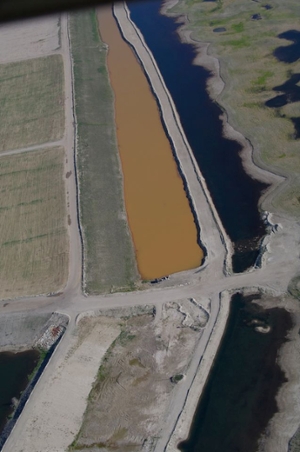
This holding pond near Opportunity, Montana, settles out sediment removed from the Milltown Dam site. The photo was taken by William Munoz from a Cessna plane flown by Erick Greene.
All along the river, efforts to remove and clean up contaminated sediment are underway. The work started several years ago and is projected to continue for about a decade and half. Check out the Clark Fork Coalition page for more info.
Over time, fish have returned to the river where they were gone or decimated. And, with the fish, other parts of the aquatic ecosystem have come back to life – among them the ospreys. However, the natural system won’t be back to normal for a long time. Missing or altered vegetation along the upper reaches of the Clark Fork River, unnatural invertebrate (insect) fauna and lower than normal fish density are some of the more obvious problems, as well as severe limits to human use due to high arsenic and mercury levels. Understanding how heavy metals affect ospreys and tracking any changes over the years will help scientists and policymakers assess the effectiveness of the Clark Fork River Superfund clean-up.

View of the Clark Fork River from the Hellgate nest; shadow of the nest in the left lower corner.
The graph below is from a study done by our researchers. It shows concentrations of arsenic, cadmium, copper, lead and zinc. Contaminant concentrations are shown in the blood of osprey chicks raised along the Clark Fork River (left panel) and tributaries (right panel). Each dot represents the average of one nest over the years, and the vertical bars show the range of measurements among all chicks and years from the same nests.

These levels are compared against contamination in river sediments to discern patterns. Generally, concentrations in sediment decrease in the downstream direction away from the areas of higher contamination. See this study (Can a river heal itslef?) from one of our researchers about heavy metals in the Clark Fork River.
Other studies reveal how these patterns translate into biological systems: a lot of organisms in the river are heavily affected by these concentrations. For example, the fish communities in contaminated sections are less abundant and/or less desirable than in uncontaminated sections, and there have been a number of infamous fish kills that were linked to the metals, especially copper, even in the recent past.
Results from the osprey project work show that the contaminant levels in ospreys do not generally follow this trend. Arsenic is the only one of the elements following the same trend as in the river, but concentrations are not considered in the toxic range. The diagram above shows copper, zinc and lead concentrations are very similar throughout the watershed (cadmium levels are not shown because they were very low and are not of concern either.) This indicates that the ospreys are able to regulate these metals very well. So, while the fish supply may be affected by the metals coming from Butte and Anaconda, the ospreys do not seem to have a lot of direct problems with these contaminants.
But then scroll up and check out the mercury levels.
Although this metal has not been considered at all in the planning of the Clark Fork River remediation, it is now the main driver of the osprey study.
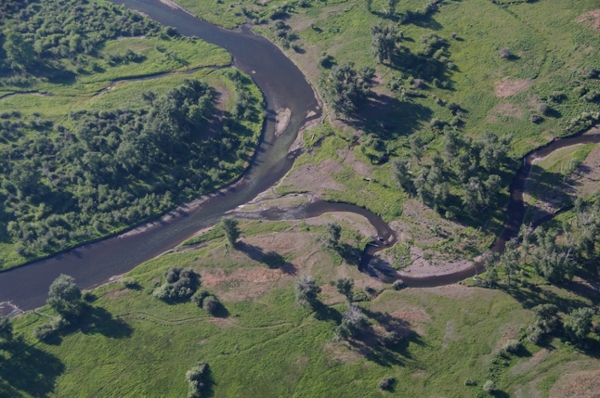
Mercury levels in osprey chick blood spike after Flint Creek meets the Clark Fork River.
The photo was taken by William Munoz from a Cessna plane flown by Erick Greene.
Mercury is a potent neurotoxin, meaning that it especially affects the brain. In the graph above mercury levels in osprey blood vary between 100 and 800 micrograms per liter (µg/L) throughout the study area. To put this in perspective, the accepted threshold for humans is 5.8 µg/L, above which there is a measurable loss in IQ.
This means the average osprey chick has about one hundred times more mercury in its blood than what is considered problematic for humans. And consider this: As long as the ospreys grow, a lot of the mercury from their food is deposited in growing tissues, especially the feathers, which keeps the concentrations in the blood low. This usually coincides with chick sampling, so the mercury measurements are low compared to non-growing birds.
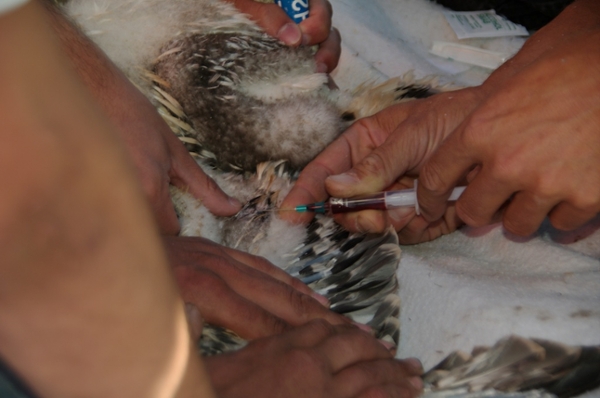
Our researchers draw blood from chicks to determine the heavy metal content. Photo courtesy of William Munoz.
As soon as growth stops, shortly before fledging, mercury levels start rising really fast because the birds keep all the mercury from their food within their body. For example, a sample from an injured osprey a month after fledging had mercury levels at nearly 3000 µg/L, up from about 300 when s/he was a chick in the nest.
Some researchers assume that the toxicological effects of mercury in humans and birds are the same, so there must be some health effect on these ospreys. On the other hand, fish-eating predators such as ospreys must have evolved with higher mercury exposures than others, because rivers and the ocean are naturally higher-mercury environments. There is not enough scientific evidence to prove either suggestion right or wrong. For example, 3000 µg/L is in line with concentrations where researchers have found decreased reproductive success or behavioral abnormalities in birds (NPS; Bio One). Others have not found any drop in the number of chicks fledged from nests with similar or higher blood mercury concentrations (AECT).
In summary, we don’t know for sure how much mercury the osprey can handle, because nobody ever truly tracked chicks that grew up in high-mercury environments. In the worst imaginable case, osprey in the Clark Fork River may not live very long and may be replaced periodically by others from less contaminated regions. Our study tries to fill in this gap by banding the osprey chicks and studying their movements as well as monitoring nests along the Clark Fork River.
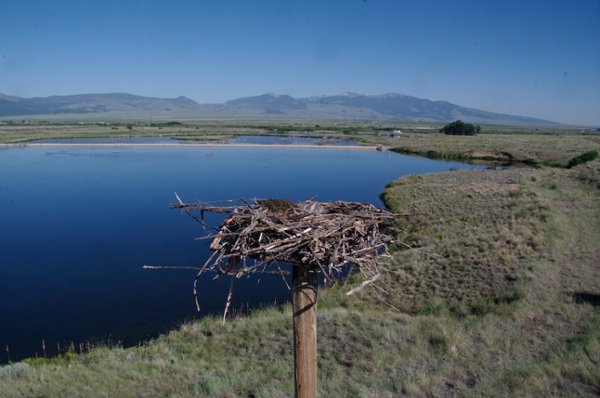
The nests are ideal natural labs that provide a greater understanding how heavy metals affect ospreys. This not only reveals contamination thresholds for the species, but may help researchers and policymakers assess the effectiveness of cleaning up the Clark Fork River.
For more info: check out the Clark Fork Coalition, the EPA's Superfund page and Montana Department of Environmental Quality.


